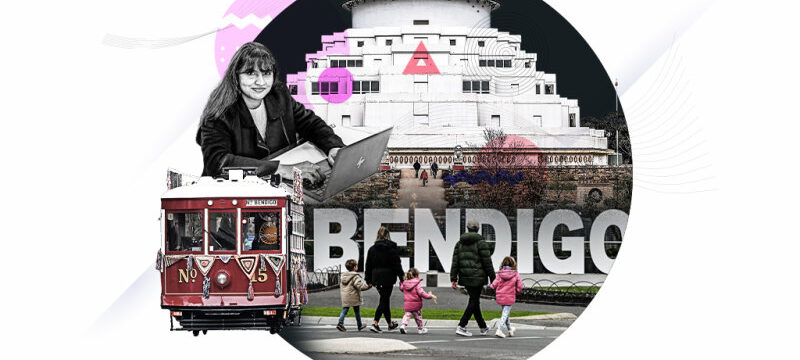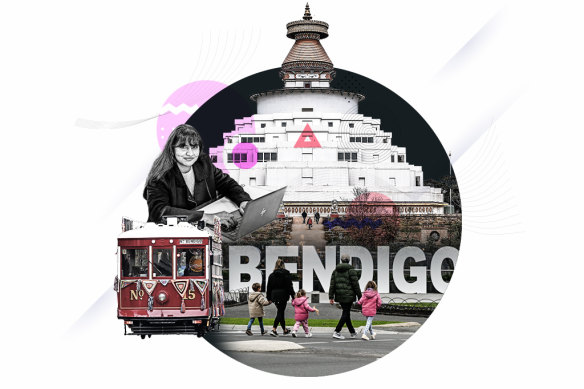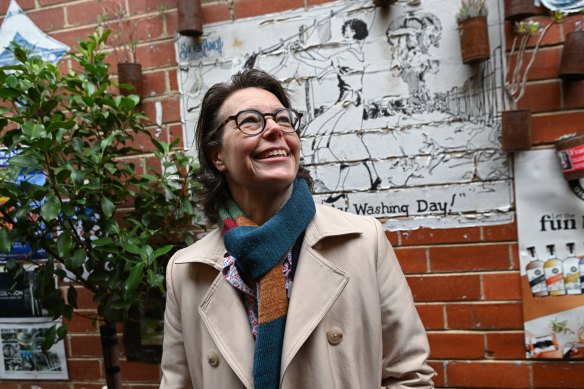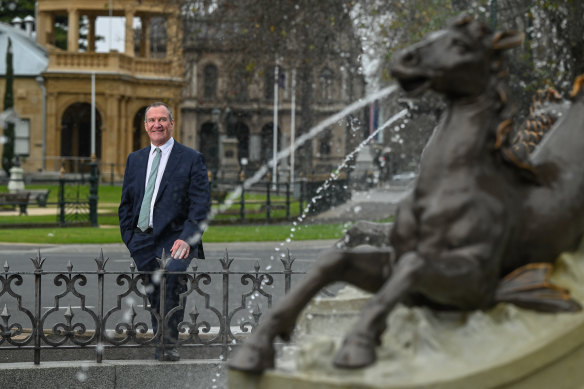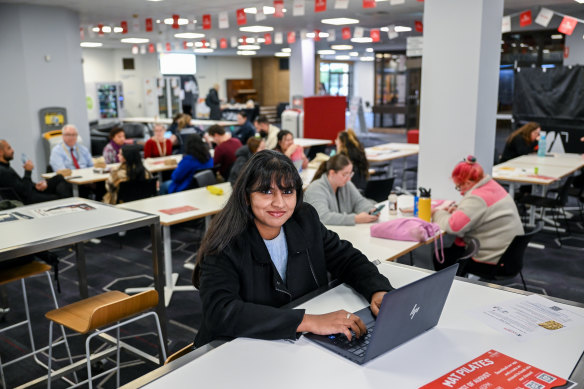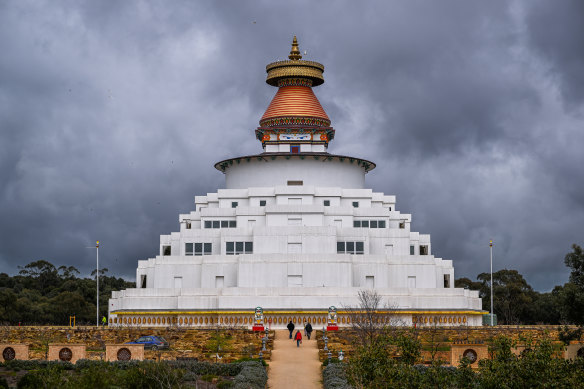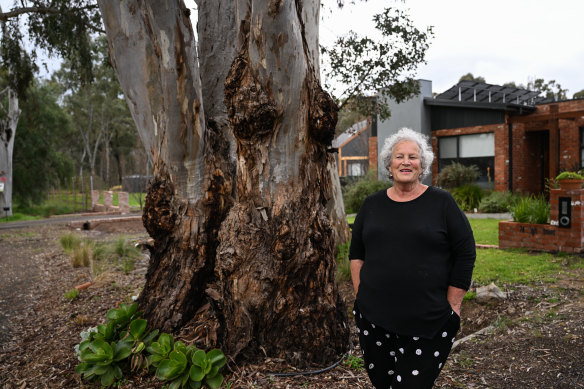By Benjamin Preiss
Many international students have settled in Bendigo.Credit: Illustration: Marija Ercegovac
Save articles for later
Add articles to your saved list and come back to them any time.
As Julie Rudner wanders Bendigo’s streets, with their elaborately decorated Gold Rush-era buildings and narrow alleys, she can almost see the city’s future.
In that vision, the heritage shopfronts remain, but apartments rise discretely above them, housing inner-city workers and students — both Australian and international. The apartment buildings are set back from view at street level, constructed with recycled concrete and painted in bold colours — turquoise, vivid yellows, earthy tones.
Rudner, La Trobe University’s Bendigo campus director and experienced town planner, imagines this future because the regional city is growing rapidly.
“Through the central business district I definitely see high-rise buildings of about 10 to 15 storeys,” Rudner says. “None of this 30-storey stuff. That would be unimaginable.”
Julie Rudner, La Trobe University’s Bendigo campus director. Credit: Joe Armao
Bendigo is a historic city with deep roots in the 1800s, when miners from across the world flocked to the region. The Victoria Hill Reserve mine yielded an estimated $8 billion in today’s value.
Now, the city is hurtling towards radical demographic change.
Greater Bendigo’s population is just over 125,000, but its council expects that will exceed 200,000 by 2050.
In a series focusing on the imminent transformation of Victoria’s regional cities, The Age is exploring how Bendigo, Geelong, Ballarat, and Albury-Wodonga will change in the coming decades.
Bendigo’s leaders imagine a buzzing CBD by day and night where people live in smaller units while studying, working, shopping, eating and drinking nearby.
Beyond the city centre, they also want more train stations in existing growing suburbs while encouraging industrial development to attract big businesses to the region.
City of Greater Bendigo chief executive Craig Niemann.Credit: Joe Armao
Apartment living in the CBD
The tallest buildings in Bendigo are about six storeys high, and only about 150 residents live in the CBD. City of Greater Bendigo chief executive Craig Niemann says the council is determining how to concentrate growth in the city centre with apartments, rather than letting it all spread out in the suburbs.
“The city centre plan really accommodates eight storeys. We’ve said there is an opportunity to grow up here,” he says.
A report by SGS Economics and Planning found Bendigo’s CBD had capacity to absorb substantial residential growth. It said Bendigo’s city centre had 1107 residents in 2021. The report forecast that population would rise to 1497 under a “base case” scenario, with 0.8 annual growth by 2050. On the upper end of the forecast spectrum, the inner-city population would almost quadruple, hitting 4041 over the same period.
Niemann and Rudner agree international students, migrants, retirees and white-collar workers willing to live in apartments are key to Bendigo’s prospects of populating the CBD.
Aurlene Jayadhas has moved to Bendigo from Chennai, India.Credit: Joe Armao
They hope to attract more students like Aurlene Jayadhas, who moved to Bendigo last year from Chennai, one of India’s largest cities, with a population of more than 12 million people.
Jayadhas chose La Trobe University’s Bendigo campus, in part because she wanted to focus her research on rural health. She is among about 400 international students representing 36 countries enrolled at the Bendigo campus among a total student body of 3200.
She lives within a 10-minute walk of the city centre and has no regrets about choosing Bendigo.
“If you come to campus early in the morning, you see a lot of roos,” she says.
“It’s amazing. It’s safe, it’s quiet. People are a lot more friendly and approachable. In comparison to Chennai, of course, it feels like a small place. People who are extremely extroverted or have a bustling lifestyle might not like Bendigo.”
The Great Stupa of Universal Compassion on Bendigo’s outskirts.Credit: Joe Armao
The city of many faiths
Jayadhas is part of an increasingly global make-up in Bendigo. In the 2016 census, 19,376 Bendigo residents reported one or both of their parents were born overseas. In 2021, it was 24,839.
The number of people who said both parents were born in India grew from 773 in 2016, to 1273 in 2021. Those claiming Filipino heritage rose from 385 to 773 over the same period.
Ian Green has seen this growing diversity first hand, in his role as chairman of the Great Stupa of Universal Compassion, a Buddhist temple and interfaith park on Bendigo’s outskirts. It has the largest stupa – or Buddhist shrine – in the Western world, and it is expanding.
A new nunnery is under construction and the interfaith Peace Park is growing too, adding new spaces and monuments beyond the existing Buddhist, Christian, Hindu, Sikh, Jewish and Muslim places of spiritual and religious reflection.
The temple’s visitation figures offer a striking example of Bendigo’s change. Before the pandemic, there were about 33,000 visitors a year, compared to more than 100,000 so far in 2023.
Green was born in Bendigo, but spent his 20s working in Melbourne and then travelling in India. He says Bendigo is much more sophisticated now with its diverse range of international cuisines that have helped it achieve UNESCO city of gastronomy status.
Affordable housing is part of Bendigo’s appeal. The median house price in the regional city was just above $564,000 in August — much more affordable than the $914, 3000 for a home in Melbourne’s outer east, according to CoreLogic.
The healthcare and social assistance sector is the top source of employment, which also helps attract new residents to the region. Last year, the sector accounted for more than 11,500 jobs in Bendigo, with many workers based at the city’s hospital, which was completed in 2018.
Retail, construction, education and manufacturing round out the top five employment industries. Bendigo TAFE and La Trobe University are major employers.
But as more people move to Bendigo, it’s becoming harder to find a parking spot in the CBD, says Robert Herbert, chief executive of Bendigo’s chamber of commerce.
Herbert believes Bendigo’s CBD will be successful in future if people can move about freely without cars – a lifestyle that involves more walking and cycling as the population swells and lowering emissions becomes a greater priority.
Commonwealth Games fallout
He also worries the cancellation of the Commonwealth Games is a missed opportunity to rejuvenate the cityscape with bike trail and footpath upgrades.
City leaders had wanted a new train station at the Bendigo Showgrounds in the lead-up to the Games, although the state government dashed hopes of delivering that project before cancelling the event. But Herbert says a new station would ease the reliance on cars in a growth area that is set to attract more residents.
“The train goes straight past there,” he says. “We just don’t have a platform.”
The state government has no plans to build a train station at the showgrounds, but has delivered three new stations for growing Bendigo communities at Goornong, Huntly and Raywood.
SGS Economics and Planning principal Pat Fensham agrees the Games cancellation is a setback. The athletes’ village was to be built in Flora Hill — a residential suburb of mostly freestanding homes about 5 kilometres from the city centre.
Fensham says this project could have been a catalyst for good quality, higher density living.
The state government insists the Flora Hill site will be considered for future housing.
Kick-starting an apartment and townhouse market could require government backing, Fensham says, to show it can be done.
Growth suburbs are shouldering almost all the residential expansion, although Fensham believes greenfield land is a limited resource.
“Bendigo has more constraints for growth because it is largely surrounded by bush.”
Last year, 740 building permits were approved in Bendigo, including 231 in greenfield areas. So far this year, there have been 376 approvals, with 191 in greenfield sites.
The former rural farming village of Marong is among the areas absorbing growth. Marong’s population has exploded from about 300 a decade ago to 1500.
The City of Greater Bendigo has identified Marong as a major growth area, with a forecast population of 8000 by 2035. The council has also purchased 155 hectares of land for industrial development at Marong.
Growth suburbs lack the basics
Herbert, chief of Be.Bendigo, is keen to see more of it. He says more industrial sites will help Bendigo attract major businesses that will bolster the economy and create more jobs.
“There’s an urgent need now for industrial land,” Herbert says.
But Heather Wearne is among the long-time Marong residents who fear public infrastructure is failing to keep up with the community’s rapid growth.
She worries there will be too few schools in the town that still lacks basic services, including a pharmacy. “People are still moving, and we’ve got no public transport,” she says.
Marong resident Heather Wearne fears infrastructure is not being developed in line with the population boom.Credit: Joe Armao
Other communities, including Huntly in northern Bendigo and Strathfieldsaye in the city’s south-east, are housing many new residents. But the forests of Bendigo Regional Park hem the city and limit its capacity for sprawl.
Rudner believes this is no bad thing. She says greater density should be welcomed, arguing it will bring more vibrancy and better nightlife to Bendigo.
“The big cities, if they’re going to survive, will need to go up,” she says. “That will include Bendigo.”
Rudner maintains Bendigo should embrace a future as a city teeming with many thousands of students from the region and around the world who are drawn to the city’s heritage charm and the chance to undertake research at the forefront of their field.
“That’s what Bendigo can become and that’s what we have been working towards.”
The Morning Edition newsletter is our guide to the day’s most important and interesting stories, analysis and insights. Sign up here.
Most Viewed in National
Source: Read Full Article
